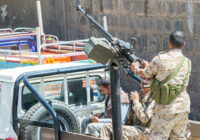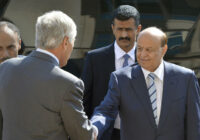What does the current turmoil in Yemen mean for the future of the country?
Yemen, often in the headlines for US drone strikes and al-Qaeda’s most active franchise, al-Qaeda in the Arabian Peninsula (AQAP), has received heightened media attention for a different reason, a successful military advance by northern Houthi rebels. Houthis are a Zaydi Shia group mostly residing in northern Yemen, led by Abdul-Malek al-Houthi. The group has taken many by surprise when it took control of the capital Sanaa on September 21, exacerbating Yemen’s already fragile security and political situation.
Houthis have often criticized the central government for discriminating against their community and have led an insurgency against Sanaa since 2004. Historically, a Zaydi Mutawakkalite Kingdom existed in Yemen from 1918-1962, ending with the brief reign of Mohammed al-Badr. The Houthi takeover of the capital this September has introduced a new dynamic into Yemen’s power constellation, with Houthi forces remaining in control of Sanaa. Their advance did not stop in the capital and there are ongoing reports about clashes between Houthis, rival tribes and AQAP fighters in several provinces, including Ibb, where they attacked the headquarters of their main chal, the Sunni Islamist al-Islah party.
In recent developments, Prime Minister Khaled Bahah has been mandated by 13 main political factions — including the Houthis — to form a new government in consultation with President Abdo Rabbo Mansour Hadi.
To make sense of the situation in Yemen, Fair Observer’s Manuel Langendorf speaks to Fernando Carvajal, a Yemen specialist with over 14 years of experience conducting fieldwork in Yemen. Langendorf and Carvajal talk about the Houthis’ political and military strategy, the current political situation and relations between the Houthis and the southern secessionist movement.
Carvajal notes on the political situation: “Forming a new government in the current situation will prove a monumental task for President Hadi.”
Manuel Langendorf: Shia Houthi rebels took control of Sanaa in September after a several months-long advance from northern Yemen. Later on, a UN-brokered peace deal was signed between the Houthis and the Yemeni government under President Hadi. What is the situation now like in the capital as fighting continues? Has there been progress toward forming a new government?
Fernando Carvajal: The signing of the peace and national partnership agreement (PNPA) on September 21 after the siege of Sanaa can be regarded as a major military and political victory for Abdul-Malek al-Houthi, the leader of the Houthi rebels. The agreement gives Houthis national and international recognition and places this non-state actor, a rebel group, at the center of a new balance of power, shouldering a new responsibility to fill the security vacuum in northern and now central Yemen.
The PNPA also represents a first step toward invalidating the political order established by the GCC initiative signed in November 2011. The Houthis did not sign the agreement that ousted President Ali Abdullah Saleh and always considered it a corrupt process imposed by foreign interference. The PNPA signed by the Houthis aimed to upset the composition of the current coalition government, which was only composed of members of Saleh General People’s Congress (GPC) and the Joint Meeting Parties under the leadership of the Sunni Islamist al-Islah party.
During the signing ceremony of the PNPA, the Group of Ten embassies (G10) was only represented by UN Special Envoy Jamal Benomar, since Houthis mostly boycott any meeting or ceremony attended by Western diplomats. The document made no mention of the G10, and the Houthi leader stated in a recent speech that the rebels would not stand for further interference by foreign powers. Abdul-Malek al-Houthi took another step to marginalize the G10 on October 25 when he called for a meeting among Yemen’s political elite to address the current crisis. The outcome of the meeting, held on October 31 in Sanaa without the presence of any member of the international community, delivered a direct ultimatum to President Hadi: Form a new government in ten days or Houthis would escalate activities against the government. The following day, Benomar witnessed the signing of a new agreement between thirteen political factions to expedite the selection process for new ministers.
Regarding the government makeover, Khaled Bahah, previously Yemen’s UN envoy, remains prime minister-designate and negotiations are ongoing to begin announcing new ministers to the 35-member cabinet. The Houthis insist the new government must represent all political forces, as opposed to the GCC initiative mandate. This new development has upset the JMP, in particular al-Islah, both of which published statements declining to participate in the new government if changes were made to the current agreement.
The relationship between Houthis and Hirak will become another source of political tension in Yemen, as Houthi activity expands to the eastern province of Hadhramawt, undoubtedly exacerbating images of Houthi ambitions to control all of Yemen.
The Houthis recently stated they are not willing to participate in the government either and that they would grant any cabinet posts to representatives of the southern movement. The Houthis’ decision to decline seats in the new government is a strategic one, aiming to preserve their public image and avoid any blame for government failures in the near future.
Forming a new government in the current situation will prove a monumental task for President Hadi. Yemen is experiencing an unprecedented degree of unpredictability with the Houthi rebels aiming to eliminate threats from AQAP militants and their tribal allies, as well as marginalize the Muslim Brotherhood affiliate al-Islah to weaken its alliances within government institutions, especially in the armed forces and security agencies like the National Security Bureau and the Political Office.
Langendorf: There are reports about clashes between Houthis and Sunni tribesman backed by AQAP in Bayda governorate. Should we see the fighting and the overall situation mainly through the lens of sectarianism and tribalism, or is there more at stake?
Carvajal: Houthi expansion in the north, and the ease with which Houthis have gained tremendous political power in Sanaa, threatens Sunni tribal forces in central Yemen, reminding them of the years under the Zaydi Imamate that ended in 1962. The population in al-Bayda province, for example, is mixed with pockets of Zaydi adherents, small numbers of Sayyid families (descendants of the Prophet) and Sunni Shafa’is that have been influenced by relatives working in Saudi Arabia since the oil boom in the 1970s, some of which became adherents to Saudi Arabia’s Wahhabi brand of Islam. This has played into the hands of AAS and AQAP leaders breeding a sectarian fight, rather than a mere political conflict.
As Houthis today are seen as sponsored by Iran, and the narrative has focused more on their Shia identity than on their Zaydi identity, it will be inevitable for the conflict in the central region of Yemen (al-Bayda, Taiz, Ibb and al-Dhale) to become a ”sectarian conflict,” especially if the fighting continues, thus allowing AQAP to present its operations as targeting Shia apostates.
The reality of the conflict involves a unique strategy employed by the Houthi leaders. They have created alliances with local tribes, many of whom are Sunnis, and loyalists of former president Ali Abdullah Saleh to fight ”terrorists.” The main problem, however, brewing as result of conflict, fought by neighboring tribes, is that the conflict may outlive the Houthi-AQAP fight and losing tribes will aim to avenge their casualties in the traditional tribal form. This scenario is what has led a number of observers to warn of an impending “civil war,” but the fact is that a low-intensity civil war has been ongoing since March 2011.
The Houthis are fighting against multiple enemies in al-Bayda. This is related to the fact that al-Bayda is the place of origin for a number of leaders from the Salafist al-Rashad party, a base for many members of the al-Islah party, and host to the al-Dhahab family whose members include AQAP sympathizers that have offered AQAP a safe haven.
Langendorf: What impact has the Houthi advance on the separatist movement in the south, Hirak? There have been large rallies calling for secession.
Carvajal: Abdul-Malek al-Houthi and the rest of the group’s leaders have announced their opposition to any secession claims by al-Hirak. At the same time, the southern separatists launched a new phase of protests for self-determination in the port city of Aden on October 14, commemorating the rebellion against Britain that later led to the establishment of the socialist People’s Democratic Republic of Yemen (PDRY) (South).
Houthis have often criticized the central government for discriminating against their community and have led an insurgency against Sanaa since 2004.
Houthi relations with Hirak extend as far back as 2007, when the former PDRY President Ali Salem al-Baydh joined protests organized by retired military officers in southern provinces. Al-Baydh, also the first vice president of the Republic of Yemen (1990-1994), has lived in exile in Beirut for nearly seven years. His relations to Lebanon’s Hezbollah and its al-Manar TV channel have fueled speculation about Iran’s role in uniting Houthis and Hirak in recent years in order to create a dual-front conflict for the government in Sanaa.
Houthis benefited from Hirak’s distraction as the rebels consolidated power in Sadah, bordering Saudi Arabia, while a faction of Hirak under al-Baydh benefited from political and material support from his base in Beirut. The Houthis never saw Hirak’s ambitions — beyond the pursuit of justice for northern aggression and looting of land and resources — as legitimate.
While having stated their opposition to southern secession, the Houthis are also trying to appease southerners by refusing to take part in the new cabinet under Prime Minister Khaled Bahah and granting their quota of government posts to southern elements. Hirak has yet to accept this offer and elements in the movement have also attacked Houthis in public statements and threaten to defend the south against Houthi expansion or attempts to impose rule from Sanaa.
The relationship between Houthis and Hirak will become another source of political tension in Yemen, as Houthi activity expands to the eastern province of Hadhramawt, undoubtedly exacerbating images of Houthi ambitions to control all of Yemen.
The views expressed in this article are the author’s own and do not necessarily reflect Fair Observer’s editorial policy.
Support Fair Observer
We rely on your support for our independence, diversity and quality.
For more than 10 years, Fair Observer has been free, fair and independent. No billionaire owns us, no advertisers control us. We are a reader-supported nonprofit. Unlike many other publications, we keep our content free for readers regardless of where they live or whether they can afford to pay. We have no paywalls and no ads.
In the post-truth era of fake news, echo chambers and filter bubbles, we publish a plurality of perspectives from around the world. Anyone can publish with us, but everyone goes through a rigorous editorial process. So, you get fact-checked, well-reasoned content instead of noise.
We publish 2,500+ voices from 90+ countries. We also conduct education and training programs
on subjects ranging from digital media and journalism to writing and critical thinking. This
doesn’t come cheap. Servers, editors, trainers and web developers cost
money.
Please consider supporting us on a regular basis as a recurring donor or a
sustaining member.
Will you support FO’s journalism?
We rely on your support for our independence, diversity and quality.






Comment